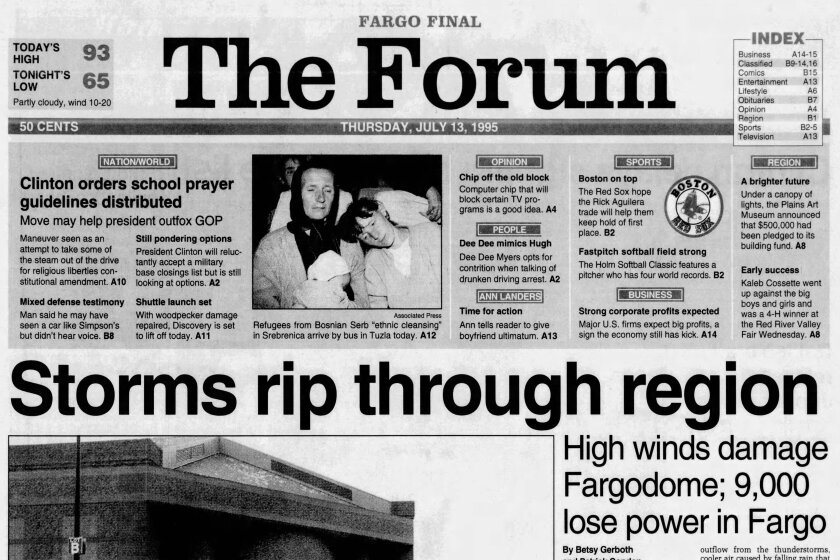On July 7, 1995, severe straight-line windstorms with gusts reaching up to 70 mph struck Fargo, North Dakota, causing extensive damage, particularly to the roof of the Fargodome. The powerful winds uprooted trees, downed power lines, and left approximately 9,000 residents without electricity, although no tornadoes were confirmed in the area.
The National Weather Service reported that the storms moved across North Dakota at an unprecedented pace of 60 mph, which is double the average for severe thunderstorms. Al Voelker, a spokesman for the agency, indicated that the winds resulted from “straight-line winds,” which are cooler air produced by falling rain that pushes ahead of the storm.
The storm system began generating severe thunderstorm warnings at 02:47 a.m. and continued until 05:10 a.m. The highest recorded wind gust of 70 mph was observed at Fargo’s Hector International Airport at 03:30 a.m. Paul Johnson, executive director of the Fargodome, confirmed that the storm inflicted over $100,000 in damage to the facility.
Impact on the Fargodome and Surrounding Areas
The damage to the Fargodome was significant. Winds peeled off a 50-foot-by-120-foot section of sheet metal from the northwest corner of the roof, scattering debris across the parking lot. Dome officials discovered the damage early in the morning, and operations director Jeff Kossow announced that work on a temporary roof would commence shortly thereafter.
Kossow also indicated that meetings with the facility’s insurance adjuster were scheduled to ascertain the full extent of the damages. The storm’s timing was notable as it occurred almost two years after torrential rains had flooded much of the Fargo-Moorhead area, including the lower level of the Fargodome.
In addition to the damage to the Fargodome, the storm wreaked havoc across Fargo. A sign at the Days Inn motel was twisted and bent, requiring two cranes for removal for repairs. A hangar at the West Fargo Airport experienced approximately $5,000 in damages after winds tore off a 20-foot-by-5-foot strip of sheet metal. Fortunately, the remaining six hangars at the airport sustained no damage.
City street crews worked diligently to clear away debris. Dennis Walaker, the operations manager for the city, reported that crews collected “hundreds and hundreds” of branches that had fallen from trees, with estimates indicating that between 30 and 50 large trees were either uprooted or severely damaged.
Power Outages and Community Response
The storm also caused widespread power outages, affecting approximately 9,000 homes and businesses in Fargo. Bob Thompson, electric operations manager for the local Northern States Power Co., noted that most outages originated in south Fargo, where two feeder lines were knocked out. By midday, repairs were underway, and Thompson anticipated that power would be fully restored by the end of the day.
Residents shared their experiences of the storm’s ferocity. One individual from north Fargo recounted waking up to find his second-story window screen missing and a box fan ejected from his home. He described his trepidation about venturing outside due to the storm’s intensity.
Laurie Nielson, a resident near the Sheyenne River, compared the storm’s noise to “a freight train” and took her family to the basement as the power went out. Although she suspected a tornado, the National Weather Service denied such claims, categorizing the event strictly as a thunderstorm. Nielson remains unconvinced, stating, “There is no doubt in my mind that it was [a tornado].”
As the storm and its aftermath unfolded, the community of Fargo came together to address the damage and restore normalcy. The swift response of city crews and local organizations highlighted the resilience and solidarity of the residents in the face of severe weather.
